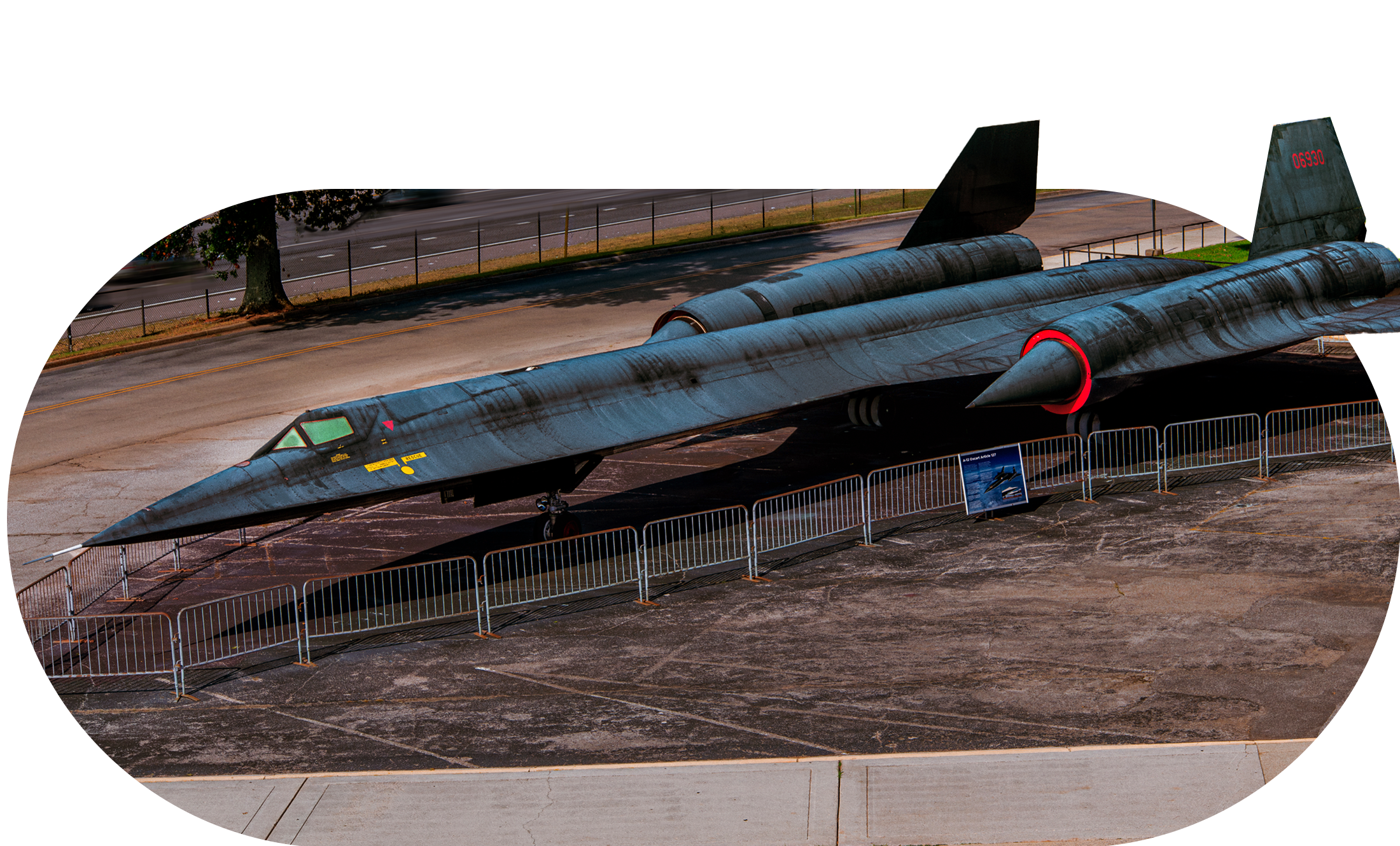Adopt an Artifact This May
This May, join us in honoring the Year of Aviation by Adopting an Aviation Artifact at the U.S. Space & Rocket Center!
It’s more than a donation—it’s your chance to adopt a piece of history and help preserve the legacy of flight for future generations. Every artifact has a story. With your support, those stories will continue to inspire.
Be a part of aviation history.
Adopt today and make a lasting impact.
Adoption Levels
$25 Adoption Kit
- A personalized adoption certificate (PDF download only)
- A photograph and history card of your adopted artifact (PDF download only)
Kits will be emailed for download.
$75 Adoption Kit
- A personalized adoption certificate (8.5×11)
- A photograph and history card of your adopted artifact
- 3-month trial to the Space Camp Explorers Club
Kits will be mailed 2 to 3 weeks after purchase.
Adopt$150 Adoption Kit
- A personalized adoption certificate (8.5×11)
- A photograph and history card of your adopted artifact
- 6-month trial to the Space Camp Explorers Club
- Your name listed for two years on the Foundation’s Adopt an Artifact page
- An entry to win two tickets to the Space Camp Hall of Fame dinner
Kits will be mailed 2 to 3 weeks after purchase.
$300 Adoption Kit
- A personalized adoption certificate (8.5×11)
- A photograph and history card of your adopted artifact
- 6-month trial to the Space Camp Explorers Club
- Your name listed for two years on the Foundation’s Adopt an Artifact page
- An entry to win two tickets to the Space Camp Hall of Fame dinner
- An entry to win artifact and space themed goodies around the holiday
Kits will be mailed 2 to 3 weeks after purchase.
$500 Adoption Kit
- A personalized adoption certificate (8.5×11)
- A photograph and history card of your adopted artifact
- 8-month trial to the Space Camp Explorers Club
- Your name listed for three years on the Foundation’s Adopt an Artifact page
- An entry to win two tickets to the Space Camp Hall of Fame dinner
- An entry to win artifact and space themed goodies around the holiday
- Virtual meet and greet with a docent about your artifact
- Virtual meeting from the Executive Director of the Foundation, Chair of Foundation Board,
and CEO of the Rocket Center providing annual update for the Center
Kits will be mailed 2 to 3 weeks after purchase.
$1,250 Adoption Kit
- A personalized adoption certificate (8.5×11)
- A photograph and history card of your adopted artifact
- 10-month trial to the Space Camp Explorers Club
- Your name listed for four years on the Foundation’s Adopt an Artifact page
- An entry to win two tickets to the Space Camp Hall of Fame dinner
- An entry to win artifact and space themed goodies around the holiday
- Virtual meet and greet with a docent about your artifact
- Virtual meeting from the Executive Director of the Foundation, Chair of Foundation Board,
and CEO of the Rocket Center providing annual update for the Center - Behind the scenes tour for you and 4 guests
- Invite to an additional private event
Kits will be mailed 2 to 3 weeks after purchase.

A-12 Oxcart was the successor to the U2 Spy plane and developed by the CIA. The Oxcart became operational in 1965. Single seat aircraft unlike the SR-71. In creating the Oxcart new cutting edge innovations took place in titanium fabrication along with new jet fuels and flight controls, electronic counter measures, along with the pilot life support system. Speed Mach 3.2 or just over 2200 miles per hour at 90,000 ft. Camera system on the A-12 was better than the 71 but the 71 could collect more data giving the 71 an advantage.
Thank you to these $150-plus Adopt an Artifact donors.
The Stout Family
In Honor of Elizabeth Garrett
In Honor of Myles Leazott
Warren Mason
Joshua Pietrzyk
Gautam Shah
Lee Smith
Kevin Flahaut
Rob Daily
Andrew Salas

This aircraft, an F-14A, Bureau Number 160661, was a part of Navy Fighter Squadron VF-51, aboard the USS Carl Vinson (CVN-70) on its maiden voyage and in VF-124 at Naval Air Station Miramar, CA, where it served as a training aircraft. This aircraft also participated in a NASA effort to improve F-14 maneuvering. The F-14 Tomcat was a supersonic, twin-engine, variable sweep wing, two-seat fighter designed for the US Navy. The F-14’s AWG-9 radar was a powerful Pulse-Doppler, multi-mode system that tracked up to 24 targets simultaneously, attacked six targets with its Phoenix AIM-54A missiles closed-circuit while continuing to scan the airspace.
Thank you to these $150-plus Adopt an Artifact donors.
In Honor of Joseph Corso
In Memory of Gerald Powers
Taylor Ford
William “Hotdog” and Tosha Hudson
Wes Kelley
Brian Kirkland
In Honor of Joint Task Force 15
In Honor of James May
In Honor of Mark Zinck
In Honor of Makayla Shane
Daniel Thompson
Kaeden Vallejo
In Honor of Lucas Young
Robert McDermott
S.D.B. Consultants, LTD
Zachary Colescott
Cassandra Reid
Mason Nall
Emily Costigan
John “Goose” Guzior
Christopher Malone
George Adornato
Gretchen Green
Andrew Salas
Holton Jackson

The Pathfinder was constructed at the Marshall Space Flight Center in 1977 as an Orbiter Simulator. It was designed to be a stand-in for the Orbiter Enterprise, which was to be involved in extensive ground testing at the center. In early 1978, the Pathfinder was hoisted to the top of Marshall’s 4OO-foot tall Dynamics Test Stand in “dry runs” for the Mated Vertical Ground Vibration Tests planned for Enterprise. It was destined to become part of the world’s only launch configuration (full stack) shuttle display. In May of 1988 Pathfinder was placed on top of the External Tank in Shuttle Park.
Thank you to these $150-plus Adopt an Artifact donors.
John Cannon
Michael Cosner
In Honor of Olivia Saraceni
In Honor of Tyler Dobson
In Honor of Renee and Lauren Driver
In Honor of the Eckard Family
Kevin Ficek
Veronica Foreman
In Memory of Crew of Columbia’s STS 107
Kyle and Kim Freundl
James Gamble
In Honor of Olivia Hammond
Brian Kirkland
In Honor of Jack Ellis
David McKinley
Scott Mickle
Jimmy Powell
In Honor of Grace Roberts
Tim Rosener
Peter Ryan
Patricia Sallin
Keith Schonrock III
Robert Shaw
In Memory of Quentin Soprano
In Memory of Joshua Stokes
In Honor of Bruce Thomas
In Honor of Sarah Grace Walder
C & M Property Holdings LLC
Solar Eclipse Timer
Kevin Flahaut
Jacqueline Brody
Brian Dicken
Christopher Lane
Jonathan Hinds
Moses Chen
Charles Woodward
Sharon Timmons
Jennifer Clouse
Frederick Lawrence
John Freeze
Gretchen Green
In Memory of David A. Belcher
Carole Graham
Christina Hansen
In Honor of Space Camp Counselors Everywhere!
Doug Hibbard

Thank you to these $150-plus Adopt an Artifact donors.
Nokomis Deckard
Olivia Saraceni
Elaine Ciaccio
Scott Harbour
Gretchen Green
Jeremy Hooper
Matthew Koebbe
Frequently Asked Questions
-
What does it mean to preserve, conserve or restore artifacts?
Taking actions that anticipate or prevent deterioration, maintaining an item in its original condition, or returning the deteriorated item to its original or near-original condition.
-
Will my donation go to conserve a specific artifact?
Yes. You will have the option to choose which artifact you would like to adopt in the drop-down menu.
-
Can I view any of the artifacts?
Yes. Several are currently on display in our permanent exhibition areas. However, some artifacts are currently offline or in a work/storage area. To check the online status of an artifact, please email [email protected].
-
Will I get a letter for tax purposes?
You will immediately receive an email confirmation and our team will send a tax receipt/confirmation letter within two weeks of receipt of your donation.
-
Can I adopt in someone else’s name?
Yes. An artifact can be adopted in honor of or in memory of someone, or you can surprise someone with an adoption gift!

Have questions about Adopt an Artifact?
Reach out if you have a question or suggestion about the Adopt an Artifact program.
